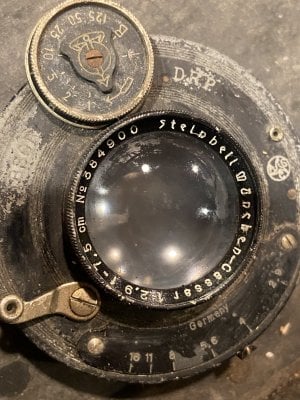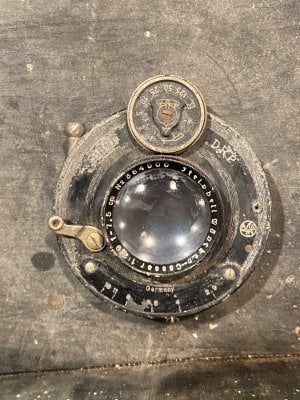Themarbleman
Newbie
Hey folks, new here. Today I was out and about looking for a 35mm camera for my sister, and ended up finding a 35mm at my first stop.
The drawback? This is a nearly 2ft long contraption of a camera. Someone made this, but why? Anyone ever seen anything like it? This camera has 3 sections to it. The top holds a large reel of film, the center is the camera mechanism, and the bottom is where the used film is stored. On the outside there is a mechanism to advance the film, a lever on the front that activates a film cutter, and a disconnected lever which somehow worked the shutter probably through some sort of linkage.
The lens does have some haze. I’m guessing it’s an old coating that’s no good. Or barn dirt.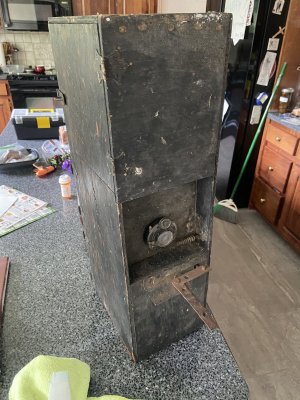
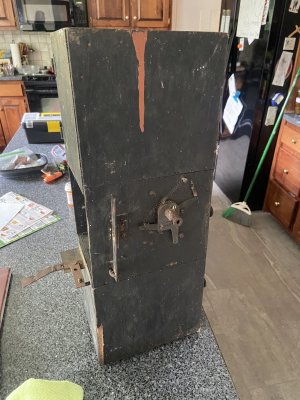
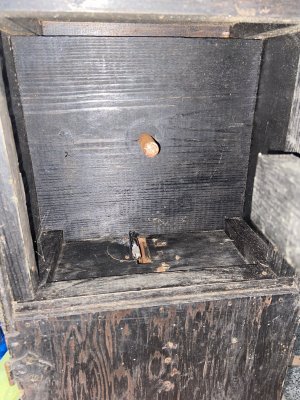
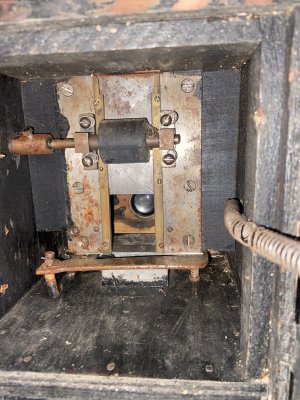
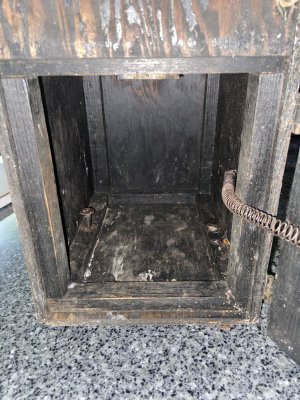
The drawback? This is a nearly 2ft long contraption of a camera. Someone made this, but why? Anyone ever seen anything like it? This camera has 3 sections to it. The top holds a large reel of film, the center is the camera mechanism, and the bottom is where the used film is stored. On the outside there is a mechanism to advance the film, a lever on the front that activates a film cutter, and a disconnected lever which somehow worked the shutter probably through some sort of linkage.
The lens does have some haze. I’m guessing it’s an old coating that’s no good. Or barn dirt.





shawn
Mentor
I just saw something kind of like that listed elsewhere and now can’t find it to get the name. That camera was a direct positive camera that was essentially a pretty early version of an instant camera. The ads for it said something like the prints cost you 2 cents each and you can sell them for 20 cents. Meant to be used at carnivals and such.
Themarbleman
Newbie
Interesting. I don’t know a ton about cameras but work with digitizing photos and negatives.I just saw something kind of like that listed elsewhere and now can’t find it to get the name. That camera was a direct positive camera that was essentially a pretty early version of an instant camera. The ads for it said something like the prints cost you 2 cents each and you can sell them for 20 cents. Meant to be used at carnivals and such.
So is this supposed to make a color positive like a 35mm slide, or a small format non-transparent photo?
I was also confused on how the shutter/lens assembly was meant for “plates”. I don’t know much about this since I only digitize photos, not take them. Does this lens meant for a larger format work alright for 35mm?
Mos6502
Well-known
What Shawn is talking about is the Mandel and Mandel-ette cameras made by the Chicago Ferrotype Company. These were essentially a tintype on paper process, an example of which from my personal collection I will attach below.
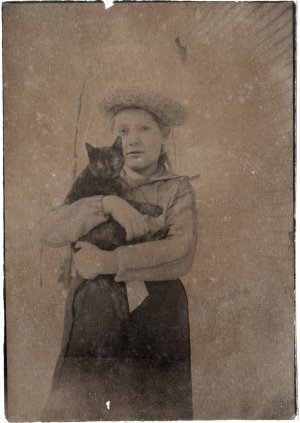
Your camera is not one of these. I suspect your camera was made for such a purpose as making photo IDs, or perhaps even a security camera (if it has an everset shutter it could be rigged to take a photo anytime somebody opened a door, or set up with a timer to take a photo once every minute) at the end of the day the film would be cut and developed. What's the shutter and lens?

Your camera is not one of these. I suspect your camera was made for such a purpose as making photo IDs, or perhaps even a security camera (if it has an everset shutter it could be rigged to take a photo anytime somebody opened a door, or set up with a timer to take a photo once every minute) at the end of the day the film would be cut and developed. What's the shutter and lens?
shawn
Mentor
Thanks, yes I was talking about the Mandel PDQ.
sojournerphoto
Mentor
That’s fascinating - thank youWhat Shawn is talking about is the Mandel and Mandel-ette cameras made by the Chicago Ferrotype Company. These were essentially a tintype on paper process, an example of which from my personal collection I will attach below.
View attachment 4837099
Your camera is not one of these. I suspect your camera was made for such a purpose as making photo IDs, or perhaps even a security camera (if it has an everset shutter it could be rigged to take a photo anytime somebody opened a door, or set up with a timer to take a photo once every minute) at the end of the day the film would be cut and developed. What's the shutter and lens?
JoeV
Thin Air, Bright Sun
Part of a Photo Booth?
DownUnder
Nikon Nomad
I remember seeing such cameras, or similar ones, in Canada as a child in the 1950s. Used at fairs and festivals for quick images of people, who paid small money for a likeness of themselves.
I also recall an old-timer photographer telling me they worked off paper negatives. Which would have involved one additional process after taking the original image as a paper negative, this being to rephotograph the original image, again on paper, for a positive print. On second looking I see this camera looks like it was set up for 35mm film. So no paper negatives were likely involved here.
These cameras were manufactured by several companies, and were popular at country fairs. Paper negatives involved a lot of work for the 20 cents or so it cost us then for a print. We had a few prints of these in our family album for many decades, but sadly this album is now lost, thrown out off thoughtlessly by my insensitive sister-in-law along with many family treasures when my mom sold the house and moved into age care in the mid-'00s.
Dating this contraption will be hit-and-miss. My guess is 1930s. What size film did it take? The assembly for it to slide across the lens looks to be for a bulk roll of some sort. Is there still a take-up spool? If yes, this will give you an idea of what film it used.
From your images, the lens and shutter assembly looks to be European, maybe 1920s. As for the rest, it looks like it was crafted in somebody's workshop from leftover bits and pieces. Not that this means it worked less well, of course.
I reckon, an ideal display piece or in someone's collection of photo oddities.
The camera will benefit from a thorough (and careful) cleaning. Try a weak dilution of sunlight soap in lukewarm water. Don't scrub!
I also recall an old-timer photographer telling me they worked off paper negatives. Which would have involved one additional process after taking the original image as a paper negative, this being to rephotograph the original image, again on paper, for a positive print. On second looking I see this camera looks like it was set up for 35mm film. So no paper negatives were likely involved here.
These cameras were manufactured by several companies, and were popular at country fairs. Paper negatives involved a lot of work for the 20 cents or so it cost us then for a print. We had a few prints of these in our family album for many decades, but sadly this album is now lost, thrown out off thoughtlessly by my insensitive sister-in-law along with many family treasures when my mom sold the house and moved into age care in the mid-'00s.
Dating this contraption will be hit-and-miss. My guess is 1930s. What size film did it take? The assembly for it to slide across the lens looks to be for a bulk roll of some sort. Is there still a take-up spool? If yes, this will give you an idea of what film it used.
From your images, the lens and shutter assembly looks to be European, maybe 1920s. As for the rest, it looks like it was crafted in somebody's workshop from leftover bits and pieces. Not that this means it worked less well, of course.
I reckon, an ideal display piece or in someone's collection of photo oddities.
The camera will benefit from a thorough (and careful) cleaning. Try a weak dilution of sunlight soap in lukewarm water. Don't scrub!
Last edited:
Themarbleman
Newbie
Hopefully I’m quoting the last message and also filling in some info.
The lens/ camera bits are German labeled ISBOR DRP. The examples of this (complete) camera online have it listed as a plate camera.
I did have success feeding 35 mm film through it just fine. And I freed up the camera bits so it now works besides the timer which is all gummed up.
This unit has no take-up reel at all. What I’m guessing is you took your photo, cranked the side mechanism once or twice, then pulled the lever on the front to cut it. I could be wrong of course. There’s no take up reel, just an empty box in the bottom which collected the used film.
Another side note here is the lens has some haze with some scratches in this haze. It seems to be either barn dirt built up or a lens costing. I’ve tried to carefully clean it with no luck.
As for what to do with it, I have no idea. As a kid I collected cameras but sold most of them years ago. Long story short, as a kid I was an awful photographer. I had a Pentax and Olympus camera and it got to the point that my folks wouldn’t get my film developed anymore. This was in the waning years of drug store development and no parent wants to spend money on all the film and failures a guess. In the end I saved my grandfathers Argus C3 and got it all cleaned up. I was planning on using it when this camera came along.
What I’m going to try and do is find a man here who does wet plate photography for cordell hull birthplace state park once a year. No one has been able to give me his contact info as of yet. I’d like to see if he either wants to borrow this unit or buy it. I work for parks and know the patrons would absolutely love to have this thing set up for demo.
What I’ve also considered is giving this thing a try in a few months when my seasonal job ends. I just worry about exposing the film with how this thing is set up. I don’t mind having it developed and sent back as just negatives since I have a high end scanner.
Just some thoughts. For $10.00 I just had to get it out of that barn and play with it. And the hunt for a generic 35mm for my sister continues. Thank you all for your input and info on this. Best bet is a carnival camera.
The lens/ camera bits are German labeled ISBOR DRP. The examples of this (complete) camera online have it listed as a plate camera.
I did have success feeding 35 mm film through it just fine. And I freed up the camera bits so it now works besides the timer which is all gummed up.
This unit has no take-up reel at all. What I’m guessing is you took your photo, cranked the side mechanism once or twice, then pulled the lever on the front to cut it. I could be wrong of course. There’s no take up reel, just an empty box in the bottom which collected the used film.
Another side note here is the lens has some haze with some scratches in this haze. It seems to be either barn dirt built up or a lens costing. I’ve tried to carefully clean it with no luck.
As for what to do with it, I have no idea. As a kid I collected cameras but sold most of them years ago. Long story short, as a kid I was an awful photographer. I had a Pentax and Olympus camera and it got to the point that my folks wouldn’t get my film developed anymore. This was in the waning years of drug store development and no parent wants to spend money on all the film and failures a guess. In the end I saved my grandfathers Argus C3 and got it all cleaned up. I was planning on using it when this camera came along.
What I’m going to try and do is find a man here who does wet plate photography for cordell hull birthplace state park once a year. No one has been able to give me his contact info as of yet. I’d like to see if he either wants to borrow this unit or buy it. I work for parks and know the patrons would absolutely love to have this thing set up for demo.
What I’ve also considered is giving this thing a try in a few months when my seasonal job ends. I just worry about exposing the film with how this thing is set up. I don’t mind having it developed and sent back as just negatives since I have a high end scanner.
Just some thoughts. For $10.00 I just had to get it out of that barn and play with it. And the hunt for a generic 35mm for my sister continues. Thank you all for your input and info on this. Best bet is a carnival camera.
EarlJam
Established
I can't quite read the text around the lens, but the lens/shutter mechanism may have been cribbed from something like the Voigtlander 116 Rollfilm camera. The camera in the photo was my mom's, from the 1930s, and also has haze between the elements. The shutter is accurate still, though, even after sitting for the better part of 7 decades since it was last used.
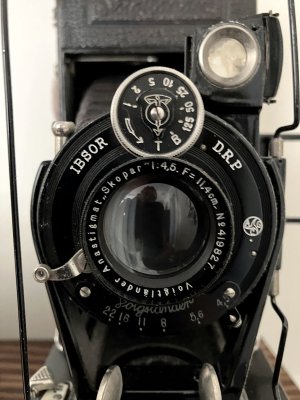

Themarbleman
Newbie
That’s in much better condition than mine. Here’s a couple photos of the lens on mine. Certainly German.I can't quite read the text around the lens, but the lens/shutter mechanism may have been cribbed from something like the Voigtlander 116 Rollfilm camera. The camera in the photo was my mom's, from the 1930s, and also has haze between the elements. The shutter is accurate still, though, even after sitting for the better part of 7 decades since it was last used.
View attachment 4837244
It cleaned up better. It’s difficult to clean the rear because of the film contraption in the back, but it should take a visible picture .
I’m wondering how on earth I can even load this with film. It looks like it took some large spool which reminds me of what a friend of mine told me. He said that speciality rolls of film you see online are often old movie 35mm. Maybe that’s how this was done. Of course I know nothing about how film was done back then besides the little loaded rolls of film.
Attachments
EarlJam
Established
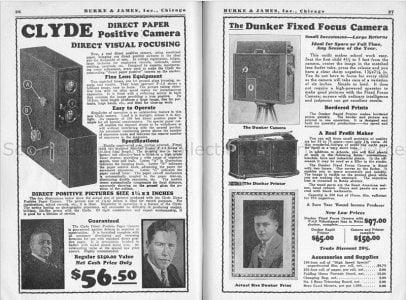
As others have noted, you appear to have a direct positive camera, such as these from a 1933 Burke James catalog. Burke James Catalog see page 15. Based on the construction, I don't think it's a film-based camera, but paper roll makes a lot of sense. Also likely not a carnival/street fair camera, as in my experience those yielded 2-14" x 3-14" paper prints and had space for processing built into the back of the camera. But it's an interesting camera nonetheless.
In my archive I have a couple of small school pictures of my dad, from the late 1920s/early 30s. The 75mm focal length on 35-ish millimeter size paper would be a short telephoto, so perhaps yielding a images like the ones on the catalog pages, but similar in concept to these.
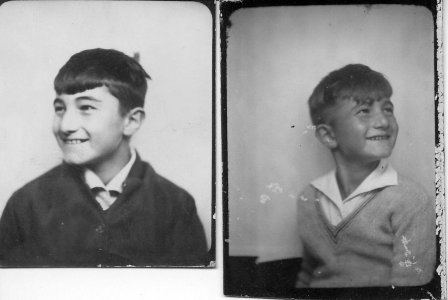
Dralowid
Michael
The lens is a Cassar made by Steinheil from Munchen (Munich), the shutter I'm not sure. Steinheil were a significant manufacturer of various optical equipment.
DownUnder
Nikon Nomad
View attachment 4837333
As others have noted, you appear to have a direct positive camera, such as these from a 1933 Burke James catalog. Burke James Catalog see page 15. Based on the construction, I don't think it's a film-based camera, but paper roll makes a lot of sense. Also likely not a carnival/street fair camera, as in my experience those yielded 2-14" x 3-14" paper prints and had space for processing built into the back of the camera. But it's an interesting camera nonetheless.
In my archive I have a couple of small school pictures of my dad, from the late 1920s/early 30s. The 75mm focal length on 35-ish millimeter size paper would be a short telephoto, so perhaps yielding a images like the ones on the catalog pages, but similar in concept to these.
View attachment 4837334
These are precious family heirlooms! I have a few in my personal archive, notably a color studio portrait of me, taken in 1953 or 1954 by a traveling photographer who came to our small town every year and used the local hotel for his sittings. Somehow I doubt he used a Clyde or a Dunker as his portraits were all done in color.
The one surviving image (of me) is a color one, now at least 70 years old and without any sign of fading. So valuable to me, indeed.
Also I was captivated by the your posting of those pages from an old Burke & James catalog. B&J sold me my first enlarger in the early 1960s, a massive 4x5" thing with one negative holder (of the largest film size) and, amazingly, a lens. It worked off a diffuser which I promptly broke, but my dad made me one in his home workshop, also a holder for 6x6 negatives as I had a newly acquired Yashica D TLR.
I paid for it (and all my other gear) in Canadian dollars which back then were worth more than the Yankee dollar, so yes, it was a long time ago.
That B&J did good work but inevitably GAS came into play and I sold it to a friend for what I had paid for it, and then bought a secondhand Beseler 23CII, also a massive thing but it had a crank to raise the head up and down without doing gymnastics. I kept the Beseler for many years and eventually sold it (to the same friend) when I returned to North America for a visit from Australia in 1982. For all I know he still has it as he has continued with his photography for over 60 years now.
Good gear lasts a long time. Your old wood 'thing' is well worth preserving and even using as a camera. It will be interesting to see what results you get from it. A second reminder from me, please post some images when you have them. We will all be keen to see them.
Themarbleman
Newbie
Thank you very much for this! I was able to get the higher res of the catalogue photo and go over it. It was for IDs, but does mention carnival use though there’s no telling where it’s spent it’s life before the barn.View attachment 4837333
As others have noted, you appear to have a direct positive camera, such as these from a 1933 Burke James catalog. Burke James Catalog see page 15. Based on the construction, I don't think it's a film-based camera, but paper roll makes a lot of sense. Also likely not a carnival/street fair camera, as in my experience those yielded 2-14" x 3-14" paper prints and had space for processing built into the back of the camera. But it's an interesting camera nonetheless.
In my archive I have a couple of small school pictures of my dad, from the late 1920s/early 30s. The 75mm focal length on 35-ish millimeter size paper would be a short telephoto, so perhaps yielding an images like the ones on the catalog pages, but similar in concept to these.
View attachment 4837334
What really got my attention was it said the paper film could be loaded in the daylight. My camera knowledge is limited but I was confused how this works. Currently due to where I’m working I have awful internet and haven’t been able to load much to research. I’d sure like to find some film sometime and start messing with it.
Not sure what I’ll do with it yet but if I can find the camera guy I keep mentioning, I’ll see if we can set it up at one of the events he goes to. He usually takes and gives a tin type photo to one lucky guest or so, but this camera would really let everyone get in on the fun.
Share:
-
This site uses cookies to help personalise content, tailor your experience and to keep you logged in if you register.
By continuing to use this site, you are consenting to our use of cookies.


